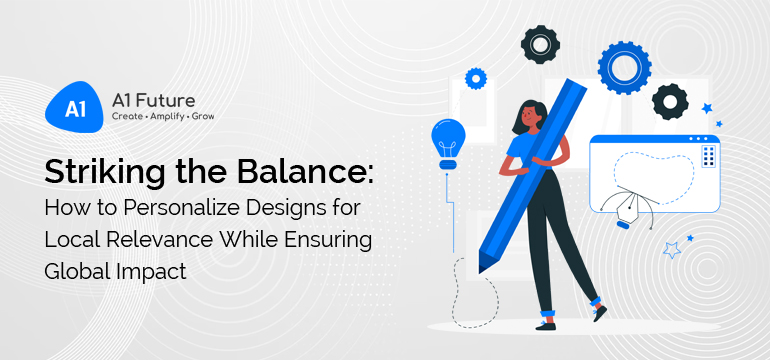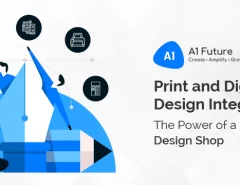Imagine a world where borders are more like dotted lines, cultures mix like a melting pot, and technology makes the globe feel like your next-door neighbor. This is the digital age we’re living in, and design in this era is something else!
Nielsen’s Global Trust in Advertising report shows that 63% of consumers prefer to buy from brands with advertising that reflects their cultural values.
So, here we are, ready to spill the beans on how to make design magic happen when you’re catering to both your local buddies and the global gang. Grab your virtual passports because we’re about to embark on a journey.
In a world where one click can connect you with someone thousands of miles away and a simple image can speak to hearts across cultures, nailing that balance between designing for your neighborhood and the whole wide world is an art form in itself.
This blog? It’s your backstage pass into the strategies that make this balancing act look easy. We’re going to dive deep into the creative toolbox and see how every brushstroke, color choice, and storytelling trick helps us create designs that turn heads worldwide while giving a nod to the rich tapestry of cultures.
So, hop on board! Let’s explore what it means to design in a world where borders blur and creativity knows no boundaries. Together, we’ll uncover the secrets of celebrating local roots while wowing the global stage—trust me, it’s a journey worth taking.
Understanding the Dual Challenge in Design: A Real-World Example
Imagine you’re the head of marketing for a global tech company. Your task? Launch a new product, a cutting-edge smartphone, simultaneously in various countries. This is where the dual challenge of design comes into play.
Local Relevance:
In India, you recognize the importance of acknowledging local preferences. The Indian market loves bigger screens, so you ensure the smartphone’s display caters to this preference. Additionally, India’s love for photography is legendary, so you tailor your marketing campaigns to highlight the phone’s camera capabilities, specifically its low-light photography mode, which is perfect for capturing vibrant Indian festivals.
Global Resonance:
However, your product needs to maintain a consistent global brand identity. The sleek design, logo, and overall user experience should be the same whether you’re in India, the United States, or Japan. This consistency assures customers that, no matter where they are, they’re getting the same high-quality product.
So, here’s the dual challenge: how do you create a product and marketing strategy that deeply resonates with local audiences while ensuring that the core essence of your brand remains consistent worldwide?
To succeed, you don’t just translate your marketing materials into different languages; you adapt them to reflect the cultural nuances and preferences of each region. In Japan, you emphasize the smartphone’s durability and craftsmanship, traits highly valued in Japanese culture. In the U.S., you focus on innovation and cutting-edge technology, appealing to the American market’s appetite for the latest gadgets.
Here’s the heart of the matter: it’s through collateral and communication that these region-specific value propositions are conveyed. Your marketing materials act as a bridge, connecting your product with the hearts and minds of local consumers.
In the corporate world, this dual challenge in design is a pivotal aspect of international marketing. It underscores the importance of understanding and respecting local cultures while upholding a strong, recognizable global brand image.
The Power of Cultural Proficiency in Design
In a study published in the “Journal of International Marketing,” it was observed that brands that successfully bridge cultural gaps can experience up to a 69% increase in brand loyalty.
In the dynamic realm of design, where local influences blend with global trends, cultural proficiency emerges as a vital force. It’s more than just the aesthetics; it’s the engine that drives genuine connections through design.
Understanding Cultural Context is the first step:
Imagine you’re entrusted with creating a marketing campaign for a luxury car brand that intends to captivate both Middle Eastern and Scandinavian markets. Cultural proficiency enters the stage when you realize that in the Middle East, cars symbolize prestige and accomplishment, while in Scandinavia, eco-friendliness and simplicity are highly valued. Here, understanding these cultural contexts allows your campaign to communicate luxury in a way that resonates with both audiences.
Decoding Cultural Nuances:
Imagine you’re tasked with designing menus for a global restaurant chain with branches in South America and Europe. Here, cultural proficiency comes into play as you realize that South Americans appreciate robust flavors and communal dining experiences, whereas Europeans savor culinary finesse and individual portions. Your menus become a canvas for reflecting these nuances and offering an authentic dining experience in each region.
Balancing Tradition and Innovation:
Picture yourself as a designer for a traditional Japanese sake brand with aspirations for global expansion. Cultural proficiency means respecting age-old brewing techniques while infusing innovation into marketing and distribution. It’s about presenting tradition in a way that resonates with modern consumers worldwide, celebrating the brand’s heritage while introducing a fresh perspective on sake.
Respecting Diversity, Celebrating Common Ground:
Let’s say you’re the creative director of a global music streaming service catering to users in Asia, Africa, and Europe. Cultural proficiency involves acknowledging the diverse musical tastes across these regions. You celebrate the richness of musical traditions while curating playlists that bridge cultural divides and resonate with users worldwide.
In essence, cultural proficiency in design isn’t just a skill; it’s an art. It’s the ability to comprehend, appreciate, and adapt to the nuances of diverse cultures while identifying the universal elements that connect us all. It’s about crafting designs and experiences that feel personal to individuals while speaking a universal language that transcends geographical boundaries.
Adapting Design Elements: Crafting a Visual Language for All
Alright, let’s dive into the art of adapting design elements, where the magic of resonating both locally and globally comes to life.
Imagine you’re designing a website for a global coffee chain. You want to use a warm color palette to convey coziness and invite visitors to savor a cup of joe. But wait, you’re not just catering to one culture here. In some regions, that warm color might be seen as friendly and inviting, while in others, it might evoke entirely different emotions. So, you adapt. You choose colors that give off that inviting vibe universally while respecting local nuances.
Now, let’s talk symbols. Think of a heart. It symbolizes love and affection, right? But in some cultures, it might have additional meanings, like luck or courage. If you’re creating a logo featuring a heart for a global charity organization, you want it to resonate with everyone. So, you adapt. You ensure that the heart speaks the language of compassion and goodwill without unintentionally stepping on cultural toes.
And when it comes to imagery, consider telling a story through visuals. You’re designing a brochure for a wildlife conservation project that spans continents. The challenge is to depict the same passion for conservation while celebrating the diverse ecosystems. You adapt. You blend images of local flora and fauna seamlessly with a universal message of environmental care. This way, you create a visual narrative that speaks to both the local guardians of nature and the global audience that cares about our planet.
In a nutshell, adapting design elements isn’t just about making things look pretty. It’s about crafting a visual language that transcends borders, resonates with emotions universally, and respects the diverse cultures that make our world colorful. It’s the secret sauce that makes design not just beautiful but also meaningful and inclusive. So, next time you’re playing with colors, symbols, or imagery in your design, remember this art of adaptation—it’s the key to creating designs that connect with hearts across the globe.
Incorporating Storytelling:
Now, let’s dive into the captivating world of storytelling, a game-changer when it comes to designing with both local flair and global appeal.
According to a survey by the Content Marketing Institute, 70% of consumers say they feel closer to a brand after reading or watching their content.
Picture this: A design isn’t just a static image; it’s a story waiting to be unveiled. When we infuse stories into design, we’re not just acknowledging cultural nuances; we’re throwing them a grand celebration. These stories become the golden thread that weaves the tapestry of design, seamlessly connecting the local with the global.
Imagine you’re designing a product package. It’s not just about showcasing what’s inside; it’s about narrating the product’s origin, the skilled hands behind it, and the rich traditions it carries. These narratives add context, pulling the audience into a deeper connection that goes way beyond surface beauty.
Think of a cultural motif; it’s not just a visual—it’s a vessel for stories, carrying the history, beliefs, and dreams of a community. When we infuse these elements with stories, they resonate with audiences near and far, sparking curiosity and igniting conversations.
What makes storytelling truly magical is its ability to create a shared experience. Whether your audience is just down the street or on the other side of the globe, a well-crafted story can stir emotions, provoke thoughts, and build bridges of understanding. When we weave stories into design, we’re not just creating something visually stunning; we’re crafting something emotionally compelling—a design that speaks a universal language, one understood by hearts worldwide.
Client Collaboration and Feedback: The Design Jam Session
Alright, folks, let’s pull back the curtain and show you what really happens in the creative kitchen. Designing isn’t a solo act; it’s more like a jam session, and guess what? Our clients bring the groove!
Imagine this: You’ve got a vision, a beat that’s unique to your community. You share it with us—the colors, the vibe, the essence of your people. Now, this is where the magic unfolds. We bring our expertise to our design wizardry, and together, we cook up a masterpiece that’s a fusion of your insights and our creative flair.
But hold on, it doesn’t stop there. We’re not the vanishing kind; we’re in it for the long haul. As the design evolves, your feedback becomes our North Star. It’s like you’re right there with us, pointing out the tweaks that turn good into great.
And you know what makes it even more special? It’s not just about the technical stuff. It’s about the stories—the ones you tell, the ones your community shares. These stories are the colors that splash across our design canvas. This collaboration isn’t just about giving a thumbs-up or down; it’s about crafting something that’s uniquely yours while speaking a language that resonates worldwide.
So there you have it—a sneak peek into our creative kitchen. It’s a place where your insights are the secret sauce that makes our designs sizzle. It’s not just teamwork; it’s a partnership that blurs boundaries, bridges visions, and results in designs that aren’t just visuals—they’re living, breathing stories that connect with hearts around the globe.
The Bigger Picture
Through design, we build bridges that span cultures, kickstart conversations, and nurture understanding.
But it doesn’t stop there; it’s about the ripple effect. A design that strikes a chord in a local community becomes a vessel of shared identity. As it journeys across borders, it carries a piece of culture, offering a glimpse into a way of life that might be different but oh-so-relatable.
In today’s digital age, our designs become cultural ambassadors, representing communities on the global stage. They speak a language that transcends words—emotions, stories, dreams. It’s in this dance between local and global that we discover the heart of design’s true impact.
So, here’s the golden nugget: we’re not just crafting designs; we’re nurturing connections. Every stroke of creativity can touch hearts, bridge gaps, and remind us of our shared humanity. And my friend, that’s the enchantment that occurs when local relevance meets global impact—a kind of magic that goes beyond the pixels and becomes part of our collective story.




